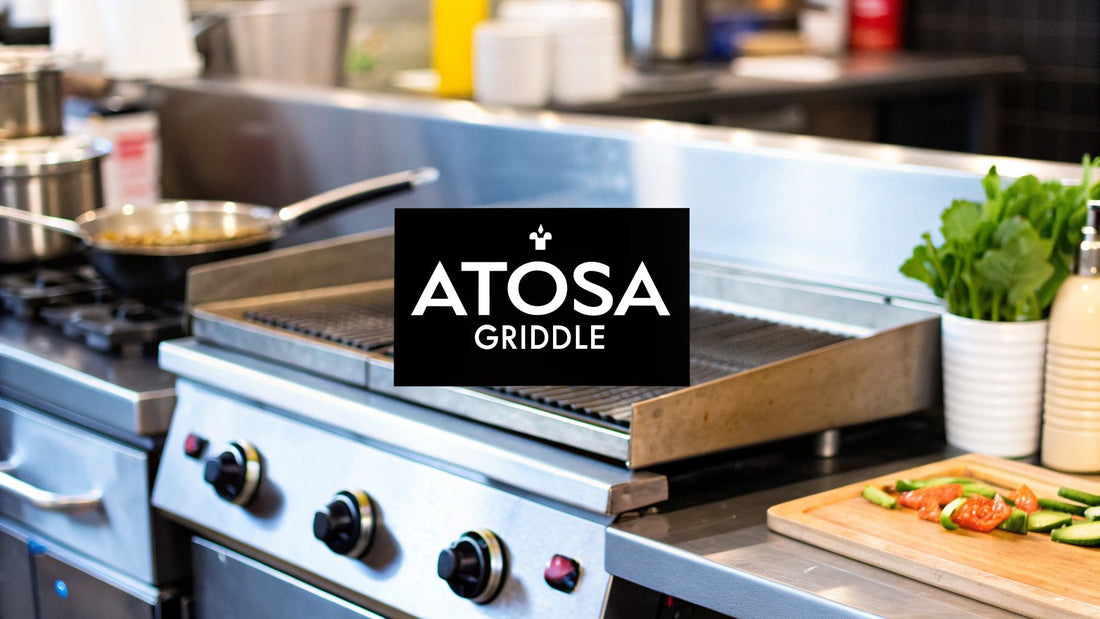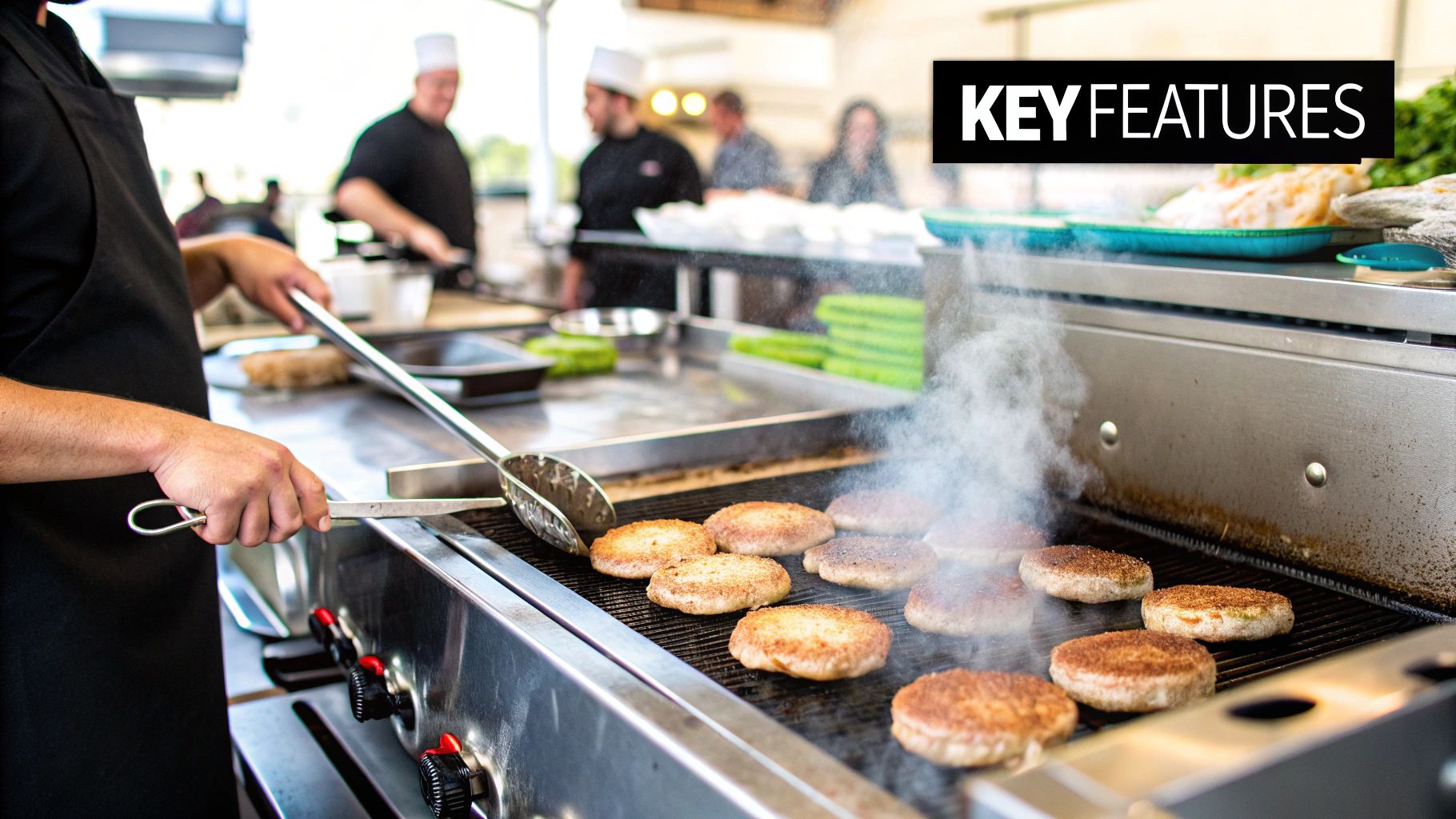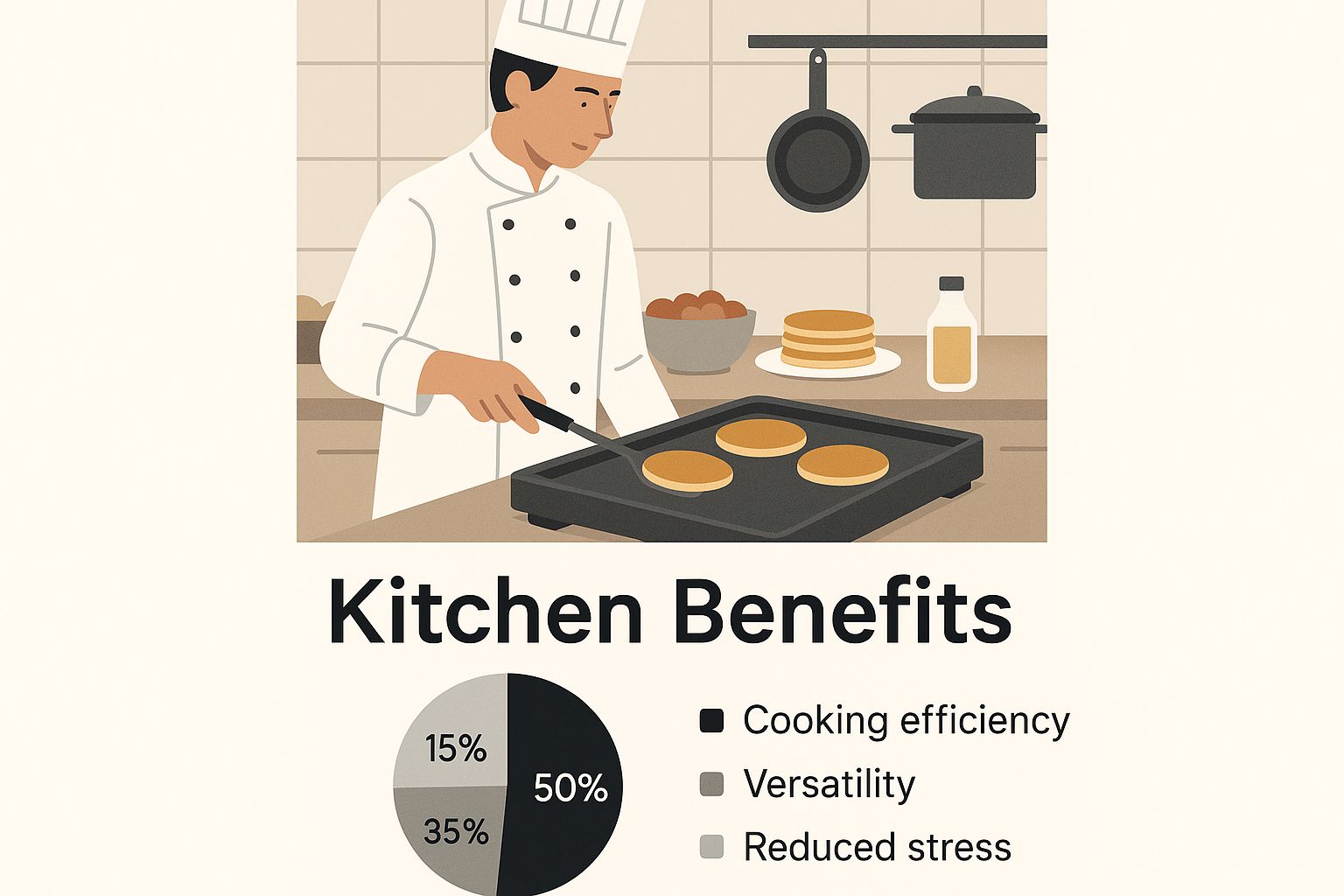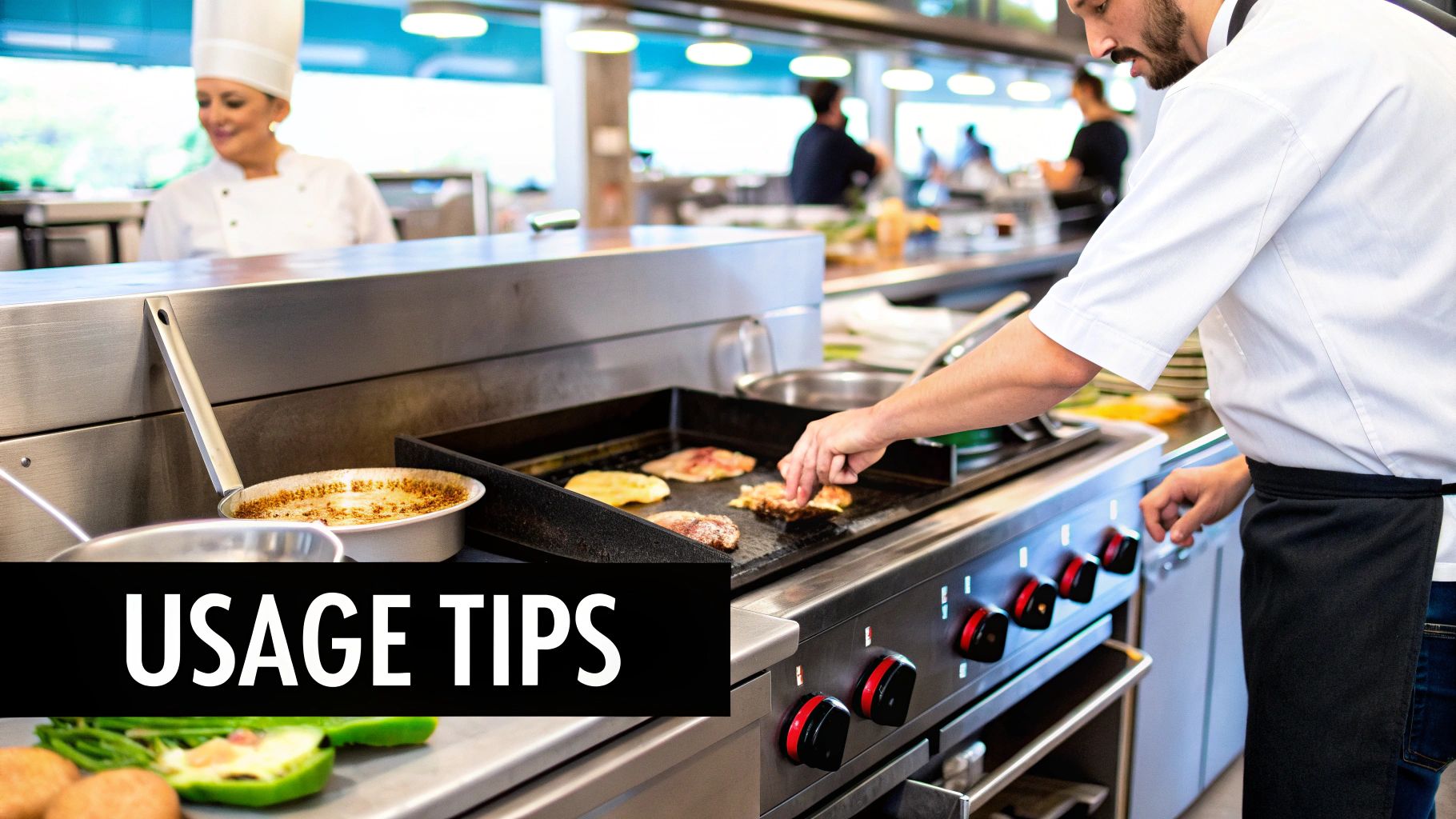
Your Ultimate Guide to the Atosa Griddle
Share
When you're in the thick of a busy service, the last thing you want is equipment that can't keep up. In the controlled chaos of a commercial kitchen, consistency is everything, and an Atosa griddle is built to be that reliable workhorse for chefs and owners alike. It's designed for powerhouse performance, delivering exceptional value without faltering under pressure. For industry professionals looking for the latest deals on top-tier equipment, Atosa represents a smart investment in operational excellence.
Why Top Chefs Trust the Atosa Griddle
For a professional chef, the griddle isn't just another piece of equipment—it's often the heart of the line. It's where everything from breakfast pancakes to dinner's signature smash burgers comes to life. The Atosa griddle has earned its stripes in these tough environments simply by delivering on its promises of durability and precision.
This trust isn't given lightly; it's built on a foundation of solid, no-nonsense engineering. The heavy-duty construction means it can handle the relentless pace of back-to-back services, day in and day out. For a restaurant owner, that translates to less downtime, fewer repair calls, and a much more predictable budget. Stay informed on exclusive deals and get the reliable gear you need to focus on what matters: the food.
A Growing Demand for Dependable Gear
It's no surprise that the market for reliable kitchen equipment is booming. The global commercial griddle market is on track to hit $1.4 billion in 2025 and is projected to expand to nearly $2.4 billion in the following five years. This growth, largely driven by expanding restaurant chains and QSRs, tells a clear story. You can dig deeper into these commercial griddle market trends on OpenPR.
This trend underscores a critical industry need: equipment that just works. An Atosa griddle meets this demand head-on by providing:
- Consistent Heat Distribution: No more frustrating hot and cold spots. You get an even cook across the entire surface, whether you're searing steaks or grilling vegetables.
- Durable Build Quality: It's made from materials that can take a beating from constant use and the daily cleaning grind.
- Operational Simplicity: The controls are straightforward and intuitive. This lets your cooks focus on their craft, not on deciphering a complicated manual.
At the end of the day, picking an Atosa griddle is about more than just buying a new appliance. It’s an investment in your kitchen's workflow, your food's quality, and your business's bottom line. It’s a true workhorse, built for the realities of the modern culinary world.
From Spec Sheet to Service Rush: How Atosa Features Really Perform

A spec sheet is one thing, but how a griddle holds up during a chaotic dinner service is what truly matters. This is where an Atosa griddle proves its worth, turning technical features into real-world advantages that any experienced chef or kitchen manager can appreciate.
Take the heavy-duty stainless steel frame. On paper, it just means durability. In your kitchen, it means having a rock-solid workhorse that won't wobble or falter through hundreds of orders a day. This tough build ensures stability and reliability, while the non-porous surface makes cleanup easier, helping you ace health inspections without a struggle.
Mastering the Art of Zone Cooking
The independent burner controls are where Atosa griddles really shine for kitchen pros. These controls let you set up different heat zones across one flat top, unlocking the power of zone cooking.
Think about it: you can get a perfect, hard sear on a steak over high heat on one section, while gently toasting brioche buns on a low-heat zone right next to it. This isn't just a clever feature—it’s a workflow revolution on your line.
This precise control means one griddle can do the job of several pieces of equipment. You save valuable kitchen space and make your cooking process smoother. Handling a varied menu becomes far more manageable when you can cook everything to its ideal temperature on a single surface.
Another crucial element is how it handles grease. A bad grease management system is a fire hazard waiting to happen and an absolute nightmare to clean. Atosa griddles tackle this with a large, easy-to-pull grease tray that's designed for a busy kitchen.
This smart design has two huge benefits:
- Minimizes Fire Hazards: It effectively pulls grease away from the hot surface and burners, making your entire kitchen safer.
- Cuts Down on Cleaning Time: A well-made grease trap dramatically reduces the time your staff spends scrubbing down at the end of a long night.
When you add it all up, these practical design choices work in concert to increase your kitchen's output, improve safety, and simply make the daily grind a whole lot smoother.
How To Choose The Right Atosa Griddle
Picking the right Atosa griddle isn't about finding the single "best" model on the market. It's about finding the best fit for your kitchen. Getting this decision right means matching the griddle to your menu, your daily customer volume, and the physical space you're working with. A well-chosen griddle becomes a workhorse; the wrong one becomes a daily source of frustration.

A great place to start is simply looking at your kitchen's layout and how much food you push out during a rush. Countertop models are a lifesaver for businesses where every square inch counts. Think food trucks, cozy cafes, or concession stands. They pack a serious punch in a small footprint. On the other hand, if you're running a high-volume restaurant or a busy steakhouse, a larger 48-inch countertop unit or a full-range model is built for that constant, demanding use. Discover exclusive deals on these models to get the best value for your operation.
Matching Plate Thickness To Your Menu
Beyond just the size of the griddle, the thickness of the cooking plate itself is a game-changer. It directly affects how the griddle cooks and recovers heat. Think of it like cooking at home: a thin frying pan heats up fast but also cools down the second you throw a cold steak on it. A heavy, cast-iron skillet takes longer to heat up, but it holds that heat steady.
It’s the same principle here:
- A thicker, 1-inch plate is your heat reservoir. It’s perfect for burger joints or steakhouses that are constantly loading it with cold proteins. The plate's mass ensures the temperature doesn't plummet, giving you consistent sears every time.
- A standard 3/4-inch plate is more nimble. It heats up faster and responds more quickly to temperature adjustments, which is ideal for a varied menu with things like pancakes, eggs, and Philly cheesesteaks that all need different heat levels.
Side-By-Side: Popular Atosa Griddle Models
To make things clearer, let’s look at how a few popular models stack up. This table breaks down their key features to help you see which one might align with your kitchen's needs.
Atosa Griddle Model Comparison
| Model Feature | Atosa ATMG-24 (Countertop) | Atosa ATMG-48 (Countertop) | Atosa AGR-6B24G (Range with Griddle) |
|---|---|---|---|
| Best For | Small cafes, food trucks, low-volume kitchens | High-volume restaurants, burger joints | All-in-one cooking stations, full-service kitchens |
| Size | 24 inches (Compact) | 48 inches (High-Capacity) | 24-inch griddle + 6 burners |
| Plate Thickness | Standard 3/4-inch | 1-inch heavy-duty option available | Standard 3/4-inch |
| Burners/Controls | 2 independent controls | 4 independent controls | 2 griddle controls + 6 burner controls |
| Key Advantage | Space-saving design | Massive cooking surface, superior heat retention | Maximum versatility in a single footprint |
Each of these models serves a distinct purpose. The right choice really comes down to an honest assessment of your menu and your operational flow.
Making The Final Call
Ultimately, the right griddle is a piece of a much larger puzzle. The demand for efficient kitchen gear is exploding, with the commercial cooking equipment market projected to grow by USD 4.47 billion between 2022 and 2027. Quick-service restaurants, which account for 44% of that market, live and die by the speed and reliability of their equipment. Staying informed on industry trends like this helps you make smarter purchasing decisions.
To make sure you've thought of everything, putting together a comprehensive list is a smart move. Our guide on creating a commercial kitchen equipment checklist can walk you through the process from start to finish. By taking the time to consider your space, menu, and desired plate performance, you'll land on an Atosa griddle that will be a trusted partner in your kitchen for years to come.
Mastering Your Griddle for Peak Efficiency
Getting a new Atosa griddle into your kitchen is exciting, but the real magic happens when you learn to master it. That's when a solid piece of equipment transforms into the workhorse that defines your kitchen's speed, quality, and workflow. Let's get into the practical steps that unlock its full potential.

First things first: you absolutely have to season the griddle plate. If you've ever broken in a new cast iron skillet, you know the drill. You'll apply a thin coat of a high-smoke-point oil and heat it until it polymerizes, creating a slick, naturally non-stick surface. Don't skip this. It's the secret to getting a perfect sear, preventing food from sticking, and making cleanup so much easier.
Setting Up for Success
Once your griddle is perfectly seasoned, you can start using it like a pro by setting up distinct cooking zones. The independent burner controls on your Atosa griddle are there for a reason! You can crank up the heat on one side for searing steaks and burgers, while keeping the other side at a lower, gentler temp for toasting buns or holding finished items.
This zoning technique turns your griddle from a simple flat-top into a dynamic, multi-tasking station. It's how you juggle complex orders and ensure every part of a dish is finished at the same time, every time.
Where you place the griddle in your kitchen line is just as important for efficiency. A smart layout can shave precious seconds off your ticket times, which really adds up during a busy service. For some great ideas on optimizing your entire kitchen flow, check out our guide on commercial kitchen design layout.
This push for greater efficiency isn't just happening in your kitchen; it's an industry-wide trend. The commercial griddle market is on track to hit $893 million by 2030, largely because of innovations in energy use and smarter controls. Atosa is right at the forefront, building equipment that helps kitchens cut down on costs while making the cook's job easier. By staying informed about the latest equipment news and trends, you can turn your griddle's advanced features into real, measurable gains for your business.
Keeping Your Atosa Griddle in Top Shape: Essential Maintenance and Care
When you bring an Atosa griddle into your kitchen, you’re not just buying a piece of equipment; you're investing in a workhorse. To get the most out of that investment and ensure it serves you reliably for years, a little bit of consistent care is all it takes.
A well-maintained griddle is the secret to great food, a safe kitchen, and smooth operations. Let it go, and you’re looking at uneven cooking, potential safety risks, and the kind of downtime no one can afford. Keeping your equipment in prime condition is a key industry trend that separates the pros from the amateurs.
https://www.youtube.com/embed/NaIF1VCNiRQ
Think of your daily cleaning routine as part of the cooking process itself. It’s what protects that perfect, non-stick seasoned surface you’ve worked so hard to create. Following a simple process not only keeps you on the right side of the health inspector but also guarantees your customers get that same great taste every time.
A clean griddle isn't just about hygiene—it's about performance. Grease and carbon buildup can create hot and cold spots, ruining the even heat distribution that makes an Atosa griddle so reliable.
Daily and Weekly Cleaning Routines
Getting your team to follow a simple checklist at the end of each day is the single best thing you can do for your griddle's health. These quick steps make a massive difference in performance and longevity.
Daily Cleaning Checklist (End of Shift):
- Scrape it Down: While the griddle is still warm (but not scorching hot!), grab a good griddle scraper and get all the food bits and excess grease off the cooking surface.
- Give it a Scrub: Use a griddle stone or a cleaning screen to gently work off any carbon that’s trying to build up. This keeps the surface smooth.
- Wipe it Clean: A clean, damp cloth is all you need to wipe the surface down. Steer clear of harsh soaps, as they’ll strip away your seasoning.
- Empty the Grease Trap: This one’s a must for fire safety. Carefully remove the grease trap, empty it, and give it a quick wash.
- Apply a Thin Coat of Oil: To finish, wipe a very thin layer of cooking oil across the clean, dry surface. This protects it from rust and keeps it ready for the next day.
Monthly Deep-Cleaning and Inspection
About once a month, it pays to spend a few extra minutes giving your griddle a more thorough look-over. This is your chance to spot small issues before they turn into major headaches.
Take a moment to check the gas lines and connections for any signs of cracking or wear. Make sure all the control knobs turn smoothly and are working as they should. This small investment of time can save you from a huge repair bill and keep your kitchen humming along without a hitch.
Frequently Asked Questions About Atosa Griddles
When you're about to invest in a kitchen workhorse like an Atosa griddle, you’re bound to have some questions. It’s a big decision. Getting straight answers is the best way to make sure you pick the right model and get the most out of it from day one. Let's tackle some of the things we hear most often from chefs and kitchen managers.
Our aim here is to clear up any confusion and highlight what really matters, so your investment pays off in kitchen efficiency and fantastic food.
Seasoning and Plate Thickness
How do I properly season a new Atosa griddle plate?
First things first, you need to get rid of any factory coating. Give the new griddle a good wash with some mild soap and water, then dry it completely.
From there, the process is simple:
- Set the heat to a medium temperature, somewhere around 300-350°F.
- Apply a very thin, even layer of a high-smoke-point oil. Canola or grapeseed oil works perfectly.
- Let the oil heat up until it just starts to smoke, then turn off the griddle and let it cool down.
- Once cool, carefully wipe off any excess oil with a clean cloth.
You’ll want to repeat this whole process 2-3 times. This builds up that beautiful, slick, naturally non-stick surface that every griddle master loves.
What is the real difference between a 3/4-inch and 1-inch thick plate?
It all comes down to how the griddle manages heat. Think of the thicker 1-inch plate as a heat battery. It takes a bit longer to get hot, but once it's at temperature, it holds that heat like a champ. This is a game-changer for high-volume spots that are constantly slapping down cold ingredients, like a burger joint during the lunch rush.
On the other hand, the 3/4-inch plate is more nimble. It heats up faster and responds more quickly when you adjust the temperature. This makes it a great fit for kitchens with a diverse menu, where you might be searing a steak one minute and cooking delicate pancakes the next.
Model Suitability and Maintenance
Is an Atosa griddle a good choice for a smaller kitchen?
Absolutely. Atosa makes some fantastic countertop models, like the ATMG-24 and ATMG-36, that pack all the power of their bigger siblings into a smaller footprint. For a cafe, food truck, or any tight kitchen space, an Atosa griddle can be the most versatile piece of equipment you own, handling everything from breakfast to dinner service.
A question we get constantly is how often the grease trap needs emptying. For any commercial kitchen, the answer is simple: check and empty it at the end of every single day. This should be a non-negotiable part of your closing routine. Built-up grease is a serious fire hazard and can create some nasty odors, so staying on top of it is critical for a safe, clean kitchen.
For more answers on general equipment care, our guide on frequently asked questions is a great resource for your entire kitchen lineup.
Ready to find the perfect Atosa griddle for your kitchen? Discover the latest news and exclusive deals on restaurant equipment and supplies at Encore Seattle Restaurant Equipment. We provide top-tier brands, expert advice, and flexible financing to help your culinary business succeed. Visit us at https://encoreseattle.com to get started.
